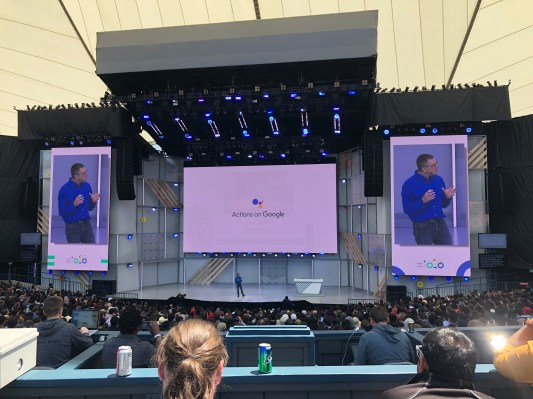Google Assistant is catching up with — and in some cases, passing — Alexa on a variety of fronts, with a wealth of new features announced today at Google’s I/O developer conference. The company is launching support for digital subscriptions in Actions (Google Assistant’s voice apps), as well as a variety of tools to help developers promote their Actions, and engage their users.
With the new support for digital subscriptions, users can purchase access to premium content through an Android application that then becomes available in a Google Action, the company announced.
Google also debuted a new way for developers to promote their voice app, called Action Links. These are hyperlinks that can be used from anywhere to point users to your voice action.
Google Assistant PM Brad Abrams offered an example of Action Links with the meditation app, Headspace. The app could promote its own accompanying voice app with an Action Link that prompts the user to activate the link in their Google Assistant.
This goes along with today’s newly launched support for better media playback in Actions. Starting today, Actions will support media playback on speakers and Android phones, Google says, giving you access to “more audio experiences like longer meditation sessions, relaxing sounds, clips from your favorite TV shows and news briefings,” the company wrote in a blog post.
Once users are acquired, another new feature called Action Notifications can help them stay engaged, he said.
Amazon had previously launched Alexa skill notifications, so this is a bit of catch-up on Google’s part.
Google’s Action Notifications are an opt-in feature users can choose to turn on in order to stay connected with an Action, and learn about new features or get updates when the app has new content.
The notifications will work on your smartphone, too — even if the Android app isn’t installed, as well as on other Assistant devices.
Another new feature enhances Assistant’s Routines, which combine multiple Actions into a single command.
With the new Routine Suggestions, after a user engages with an Action, the developer can prompt the user to add the Action to a Routine with just a couple of taps.
Google highlighted its history in search as a reason why it will excel at voice app discovery, as well.
“The broader challenge of helping people connect with the right Action is reminiscent of the early days of the web,” said Abrams. “Over the past 20 years, we’ve developed a lot of experience in connecting people with the right information, services and context, and we’re putting that to work in Google Assistant.”
On this front, the company is beginning to map into a taxonomy of user intents all the ways users can ask for an Action, which developers will be able to access via Built-in Intents.
It’s also adding Custom Device Actions for device makers who want to add specific functionality related to the platform on which Google Assistant runs. For example, a washing machine with a specific color cycle could use this feature by allowing users to activate that cycle through Assistant.
The new Google Assistant features will launch in the “coming months,” unless otherwise indicated.

